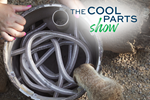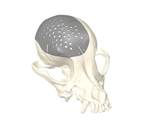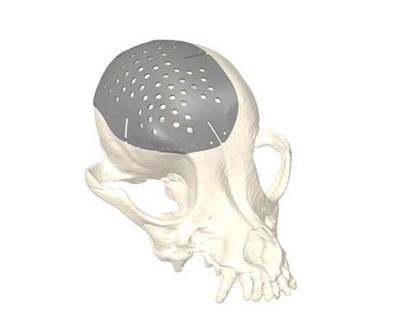Océane Da Cunha is a biologist at the University of Texas El Paso (UTEP) who gets enthusiastic about the material properties of 3D printed PLA. Those engineering properties are serving her well in her research.
With help from 3D printing, this Ph.D. candidate in ecology and evolutionary biology is learning the answer to a seemingly straightforward question: What are the predators of the western diamondback rattlesnake? Biologists seeking to understand and protect this species do not know the answer with confidence, simply because humans rarely get to witness rattlesnakes being hunted. Da Cunha’s idea: Use 3D printing to create rattlesnake models realistic enough to attract predators, place these models in the desert, and use motion-sensing game cameras to monitor what might come.

One of the 3D printed rattlesnake models in position in the desert. A camera watches nearby. Scroll down to see examples of wildlife footage that the cameras trained on the snakes models have captured. Photo credit: Océane Da Cunha.
Ground temperatures in the desert near El Paso get well above 100°F in the summer. Da Cunha was concerned her idea would fail because the plastic snakes would lose their lifelike appeal through turning soft and deforming in the heat. However, the filament used — Colorfabb polylactic acid (PLA) applied on 3D printers from Ultimaker — has a melting point of 140°F, remaining rigid even at the highest desert temperatures. These snake models have endured and are working as intended, as some of the resulting wildlife video attests (see below).
“I had the idea when I saw realistic 3D printed models that had been made for studying anatomy,” she says. “I realized we could make an anatomically accurate rattlesnake model,” and this represented a potentially important leap. Snake models used for field research in the past were made of clay. “They look like Play-Doh,” she says, and they are only marginally effective. Until now, there was no practical, cost-effective way to create a model that looked convincingly like the snake being studied — convincing enough to reliably draw predators close.

Ecology and evolutionary biology researcher Océane Da Cunha (seen here with a real snake). Photo credit: Daniel Heuclin.
Her insight, and her success at making it real, land closer to manufacturing than the wildlife research itself might suggest, because the idea illustrates various points about 3D printing’s promise for manufacturing. First, it demonstrates how precisely the tool needed to solve a given challenge can now be easily produced. Second, the question of who can be a manufacturer now has a broader answer, because an inventor with an idea can now become one. Da Cunha was briefly a serial manufacturer herself. GAIA, the makerspace on the UTEP campus, includes 12 Ultimaker 3D printers, and at one point all of them were making rattlesnake models.
Hector Lugo is an instructional technologist on the staff of GAIA, and he aided her in this project. “She brought a dead rattlesnake for us to start with,” he says. (A museum specimen, Da Cunha notes.) Using a 3D scanner along with Skanect and Qlone software, Lugo precisely captured the geometry of the animal, notably including the texture of its scales. Autodesk Fusion 360 and Meshmixer were used to sculpt the resulting model and prepare it for 3D printing.

At one point, all the Ultimaker 3D printers in the GAIA makerspace were busy making rattlesnake models. Snakes were printed in two pieces: the body (curving in snakelike fashion to fit within the printer) and the head, which was attached later. Photo credit: Hector Lugo.
Models representing different growth stages of the snake were created this way, including baby snake models printed in about 4 hours apiece and adults 80 cm long printed in about 9 hours each. (Build times are for the body. Heads were printed separately and attached.) Thirty-four rattlesnake models in all were printed. Da Cunha hand-painted each one to match the western diamondback’s coloration.
As is the way with inventors, Da Cunha and Lugo had wanted more. The models are visually accurate, Da Cunha says, but not realistic to the olfactory sense. “I thought about ways to add scent to the model,” she says, but found no practical way. This is a missing piece, because some desert predators (coyote, badger) rely on not just sight but smell. Lugo, meanwhile, wanted to add servos for realistic movement. This also proved impractical, but he says he hasn’t given up on the idea for the future. In any case, what is missing has not proven as important as what the models convey, because these realistic snake replicas have proven effective at revealing the desert’s hidden life.
Da Cunha travels out to the desert twice per week to visit her snake replica stations, exchanging SD cards to discover what the cameras watching her PLA models have seen. Predators observed so far include coyote, peccary, fox and roadrunner (which is a predator, despite what cartoons may have taught us). Another rattlesnake predator caught on film: the coach whip, a snake-eating snake.
But perhaps the most telling evidence of how well the snake models are working can be seen not in the behavior of predators, but prey. “I’ve seen small birds getting scared,” she says. “They are so convinced by the 3D printed snakes that they display their aggression response.”
Related Content
Possibilities From Electroplating 3D Printed Plastic Parts
Adding layers of nickel or copper to 3D printed polymer can impart desired properties such as electrical conductivity, EMI shielding, abrasion resistance and improved strength — approaching and even exceeding 3D printed metal, according to RePliForm.
Read More6 Trends in Additive Manufacturing Technology at IMTS 2024
3D printers are getting bigger, faster and smarter. But don’t overlook the other equipment that the AM workflow requires, nor the value of finding the right supplier.
Read MoreQ&A With Align EVP: Why the Invisalign Manufacturer Acquired Cubicure, and the Future of Personalized Orthodontics
Align Technology produces nearly 1 million unique aligner parts per day. Its acquisition of technology supplier Cubicure in January supports demand for 3D printed tooling and direct printed orthodontic devices at mass scale.
Read MoreUnderstanding PEKK and PEEK for 3D Printing: The Cool Parts Show Bonus
Both materials offer properties desirable for medical implants, among other applications. In this bonus episode, hear more from Oxford Performance Materials and Curiteva about how these companies are applying PEKK and PEEK, respectively.
Read MoreRead Next
3D Printed Animal Enrichment Device: The Cool Parts Show #22
The Cool Parts Show goes to the zoo to learn about a 3D printed enrichment device being used to challenge and engage meerkats, birds, foxes and more in this bonus episode.
Read MoreWorkflow Is Key to Delivering Custom 3D Printed Implants for Animals
A veterinary study on the use of 3D printed titanium cranial plates for dogs has established a workflow for creating these custom devices in less than 3 weeks.
Read MoreAlquist 3D Looks Toward a Carbon-Sequestering Future with 3D Printed Infrastructure
The Colorado startup aims to reduce the carbon footprint of new buildings, homes and city infrastructure with robotic 3D printing and a specialized geopolymer material.
Read More





















